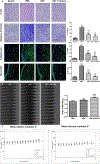Drug delivery systems for wound healing treatment of upper airway injury
- PMID: 38588553
- PMCID: PMC11208077
- DOI: 10.1080/17425247.2024.2340653
Drug delivery systems for wound healing treatment of upper airway injury
Abstract
Introduction: Endotracheal intubation is a common procedure to maintain an open airway with risks for traumatic injury. Pathological changes resulting from intubation can cause upper airway complications, including vocal fold scarring, laryngotracheal stenosis, and granulomas and present with symptoms such as dysphonia, dysphagia, and dyspnea. Current intubation-related laryngotracheal injury treatment approaches lack standardized guidelines, relying on individual clinician experience, and surgical and medical interventions have limitations and carry risks.
Areas covered: The clinical and preclinical therapeutics for wound healing in the upper airway are described. This review discusses the current developments on local drug delivery systems in the upper airway utilizing particle-based delivery systems, including nanoparticles and microparticles, and bulk-based delivery systems, encompassing hydrogels and polymer-based approaches.
Expert opinion: Complex laryngotracheal diseases pose challenges for effective treatment, struggling due to the intricate anatomy, limited access, and recurrence. Symptomatic management often requires invasive surgical procedures or medications that are unable to achieve lasting effects. Recent advances in nanotechnology and biocompatible materials provide potential solutions, enabling precise drug delivery, personalization, and extended treatment efficacy. Combining these technologies could lead to groundbreaking treatments for upper airways diseases, significantly improving patients' quality of life. Research and innovation in this field are crucial for further advancements.
Keywords: Drug delivery; biomaterials; endotracheal intubation; larynx; nanotechnology; trachea; vocal folds; wound healing.
Figures





References
-
- Durbin CG Jr., Bell CT, Shilling AM. Elective intubation. Respir Care. 2014. Jun;59(6):825–46; discussion 847–9. - PubMed
-
- Cairns CK, Kai. National Hospital Ambulatory Medical Care Survey: 2020 Emergency Department Summary Tables. National Center for Health Statistic (U.S.); 2020.
Publication types
MeSH terms
Grants and funding
LinkOut - more resources
Full Text Sources
